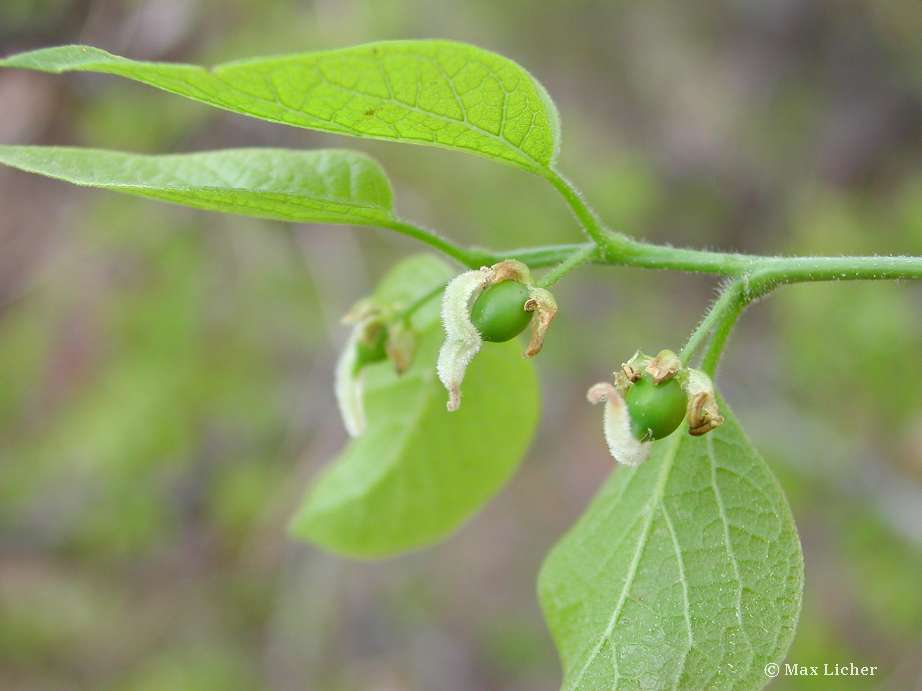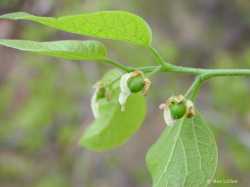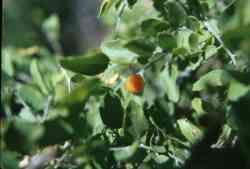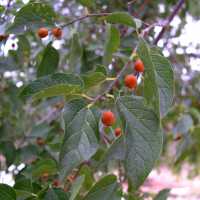Trees or rarely shrubs , to 30 m; crowns spreading. Bark usually gray, smooth or often fissured and conspicuously warty. Branches without or with thorns, slender, glabrous or pubescent. Leaves: stipules falling early. Leaf blade deltate to ovate to oblong-lanceolate, base oblique or cuneate to rounded, margins entire or serrate-dentate; venation 3(-5)-pinnate. Inflorescences: staminate inflorescences cymes or fascicles; pistillate solitary or few-flowered clusters. Flowers usually unisexual, staminate and pistillate on same plants, along with a few bisexual flowers, pedicellate on branches of current year, appearing in mid or late spring. Staminate flowers: filaments incurved in bud, exserted after anthesis; gynoecium minute, rudimentary. Pistillate flowers: calyx slightly to deeply 4(-5)-lobed; stamens 4-5, inserted on pilose receptacle, included, often nonfunctional filaments usually shorter than in staminate flowers, rarely absent; anthers ovate, face to face in bud, extrorse; ovaries sessile, ovoid, 1-locular; styles short, sessile, divided into 2 divergent, elongate, reflexed lobes, lobes entire or 2-cleft. Fruits fleshy drupes, ovoid or globose; outer mesocarp thick, firm, inner mesocarp thin, fleshy; stones thick walled, ripening in autumn, persisting after leaves fall. x = 10.
The hackberries provide important wildlife habitat, forming thickets that give shelter and fleshy drupes that ripen in autumn, persist after leaves fall, and supply winter food for birds and mammals. The treatment presented here is a simplified circumscription of species with no elaboration of infraspecific variation or interspecific hybridization. The group is taxonomically complex and in need of revision.
LEAVES: margins serrate, crenate, or entire; vena¬tion palmate at the base, pinnate at the apex.
PLANT: Trees or shrubs; branches without or with thorns.
INFLORESCENCE: uniflorous or small cymes or fascicles, appearing with new leaves.
FLOWERS: with pedicels, staminate near the base of the new spring growth, distally pistillate, the intermediate flowers sometimes perfect; calyx lobes usually 5 6, distinct nearly to the base; stamens 4 5, exserted, non functional and usually shorter in pistillate flowers; pistil reduced in staminate flowers; styles 2, plumose.
DRUPES: fleshy, ovoid or spherical, the stones thick walled. x = 0.
NOTES: 60 spp., 2 in AZ; tropical and n temperate zones. (Classical Latin, Pliny's name for Celtis australis L.). Drupes harvested by the Tohono O'odham, birds, and mammals. Wood used for fenceposts. Celtis occidentalis L., with leaves over 5 cm long and coarsely serrate at least apically, is cultivated in AZ.
REFERENCES: Brasher, Jeffrey W. 2003. Ulmaceae. J. Ariz. - Nev. Acad. Sci. Volume 35(2).
Monoecious or polygamous; staminate fls in small clusters near the base of the twigs of the season; fertile fls solitary or sometimes paired, from the upper axils of the same twigs, often lacking stamens; cal deeply 5-parted; anthers introrse; style very short, with elongate, recurved-divergent stigmas; fr a drupe with thin, ±sweet pulp and a hard stone; embryo curved; woody pls with entire or serrate lvs 3-nerved from a ±oblique base; fls ephemeral, borne in early spring. 70, mainly N. Hemisphere.
Gleason, Henry A. & Cronquist, Arthur J. 1991. Manual of vascular plants of northeastern United States and adjacent Canada. lxxv + 910 pp.
©The New York Botanical Garden. All rights reserved. Used by permission.








